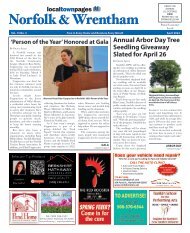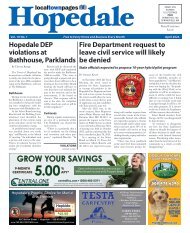Create successful ePaper yourself
Turn your PDF publications into a flip-book with our unique Google optimized e-Paper software.
Page 4 Medway & Millis Local Town Pages www.localtownpages.com February 2020
Explaining Millis’ Real Estate Tax Increase
By Dave Pasquantonio
As the calendar flipped from
December to January, Millis residents
knew that their property tax
bills were on the way. But many
residents were not prepared for
the higher numbers.
A combination of voter-approved
overrides and debt exclusions,
coupled with how the town
bills property tax, resulted in big
year-to-year increases. This led
to many calls and visits to Town
Hall and bitter discussions on
public Facebook pages.
Although the increases are
valid—Millis voters have approved
several large projects in
the last decade—the shock at
seeing those increases is equally
valid.
Millis bills property taxes quarterly.
The first and second quarter
bills are estimates based on the
previous year’s tax bills and are
mailed in July, while the third and
fourth quarter bills, which reflect
actual amounts, are mailed in
localtownpages
Published Monthly
Mailed FREE to the
Communities of
Medway & Millis
Circulation: 10,000 households
Publisher
Chuck Tashjian
Editor
J.D. O’Gara
Advertising Sales Manager
Lori Koller
Franklin & Medway/Millis
(508) 934-9608
Production & Layout
Michelle McSherry
Susan Dunne
Advertising Department
(508) 934-9608
lorikoller@localtownpages.com
Ad Deadline is the
15th of each month.
Localtownpages assumes
no financial liability for errors
or omissions in printed
advertising and reserves the
right to reject/edit advertising
or editorial submissions.
Send Editorial to:
editor@millismedwaynews.com
© Copyright 2020 LocalTownPages
January. Tax increases from the
previous year are reflected only in
the third and fourth quarter bills
instead of being spread over the
four quarterly bills. Many communities
besides Millis use estimated
bills.
A property tax bill is based
on two figures: the town tax rate
and the property’s assessed value.
Millis has a single tax rate for all
property types, while other towns
and cities tax residential and
commercial properties with different
tax rates.
In Massachusetts, Proposition
2 ½ limits the amount by which
each town can raise its property
taxes each year. But through town
meetings and ballot initiatives,
Millis residents can approve extra
spending on projects, thereby increasing
taxes.
Sometimes, these projects
raise taxes for a single year—for
example, the town might approve
a maintenance project, and
any funds needed for that project
would come from a one-time tax
increase. For each fiscal year, all
of these approved single-year
projects are added to the town’s
tax levy.
Sometimes the town approves
a large-scale project and has to
borrow money and pay it off over
a number of years or decades.
These are called debt exclusions.
Each year, the town then either
pays interest on the debt or pays
both interest and principal. These
payments are added to the town’s
tax levy.
Millis has four current debt
exclusions:
• 2010: $5 million for the library
• 2013: nearly $10 million for
the police/fire station
• 2013: $850,000 for a fire truck
• 2017: about $30.5 million for
the elementary school (the
state granted an additional
$21.5 million towards the
project)
The new school is the biggest
contributor to this year’s property
tax burden. Last year, the town
paid only interest on the debt. FY
Millis Public Library to Present
Program on National Parks
Armchair Travelers Series: National Parks
of the Eastern States, with Steve Farrar
Tuesday, February 4 th , 6 p.m.,
Roche Bros. Community Room
Not all visits to National
Parks require New Englanders
require New Englanders
to make extensive travel plans.
In this edition of our National
Parks Series, our adventure
guide Steve Farrar will take
us on a pictorial tour to visit
eight parks east of the Mississippi,
stretching from Maine
to Florida. Whether arranging
for a day trip or planning
a long weekend, you will learn
how exciting and accessible
these parks are, from the most
visited to some relatively unknown
destinations.
508-429-2535
Propane Open Sat & Sun
Gas Grill Tanks Filled
Neil Lazzaro
ASE Technician
1292 Washington Street,
Holliston
Tires & Alignment
Suspension & Steering
Exhaust & Brake
Air Conditioning
Factory Scheduled Maintenance
Mass. State Inspection Station
2020 is the first year that the town
will pay towards both interest and
principal on the school debt. The
town is already paying both interest
and principal for the other
three projects.
The tax hit for debt exclusions
is largest in the first year of paying
towards the principal. The
interest amount comes down a
little each year after that as the
principal is reduced.
The town also has to determine
how much each individual
property needs to be taxed. This
is done by assessing each property’s
value. Towns in Massachusetts
are required to fully reassess
property values every five years
(this is new—previously, it was
every three years), and assessments
can change slightly every
year.
After the town determines the
total valuation of property, it sets
its property tax rate. The tax rate
is a dollar figure per thousand
dollars of assessed value. The tax
rate by itself doesn’t indicate that
a town’s taxes are high or low—
the tax rate in combination with a
property’s assessment gives a true
year-to-year view of a property’s
tax burden.
Property taxes can’t be raised
more than 2.5 percent annually
(due to Proposition 2 ½) but
that’s before any voter-approved
overrides or debt exclusions are
tacked on.
Once the tax rate is set, multiplying
the rate by a property’s
assessed value produces that
property’s tax bill. Adding up
each property’s tax bill results in
the town’s total tax property burden.
The Millis tax rate for fiscal
year 2020 is $20.14 per thousand
dollars of assessed value. The FY
2019 tax rate was $18.70, and the
FY 2018 tax rate was $18.02.
The combination of assessment
and tax rate for an individual
property gives a true sense
of how much a town’s property
taxes change. For example, this is
the author’s tax bill over the last
three fiscal years.
• FY 2018: property assessed at
$375,500, tax rate of $18.02,
tax bill of $6,766
• FY 2019: property assessed at
$388,400, tax rate of $18.70,
tax bill of $7,270
• FY 2020: property assessed at
$409,100, tax rate of $20.14,
tax bill of $8,239
The author’s tax bill increased
nearly $1,000 from FY 2019 to
FY 2020. Because Millis taxes
property quarterly and uses estimates
for bills for the first two
quarters, the author’s third and
fourth quarter bills each increased
by about $500 over the
same quarters in the previous fiscal
year. If actual numbers were
used for each bill, then each bill
would have increased about $250.
In percentages, the author’s
tax bill increased about 7.5 percent
from FY 2018 to FY 2019.
This year’s tax bill increased a
little over 13 percent from last
year. Most of this year’s increase
can be attributed to the town paying
both interest and principal toward
the school project bonds.
At the Millis Select Board
meeting held on January 13,
Town Administrator Michael
Guzinski presented similar information
to explain the property
tax increase. That information
can be found on the town’s website.
Residents who attended were
invited to air their views on property
taxes.
The Candy Cottage
Chocolates · Truffles · Fudge · Turtles · Gift Baskets
NUT FREE, DAIRY FREE & VEGAN CHOCOLATES
For that
Special Someone…
Chocolate Roses | Chocolate Pizza
Assorted Chocolates
44 Central Street, Holliston
(508) 429-5544
Valentine week hours: Mon - Wed 10-5 • Thur-Fri 9:30-6 • Sat 10-5

















